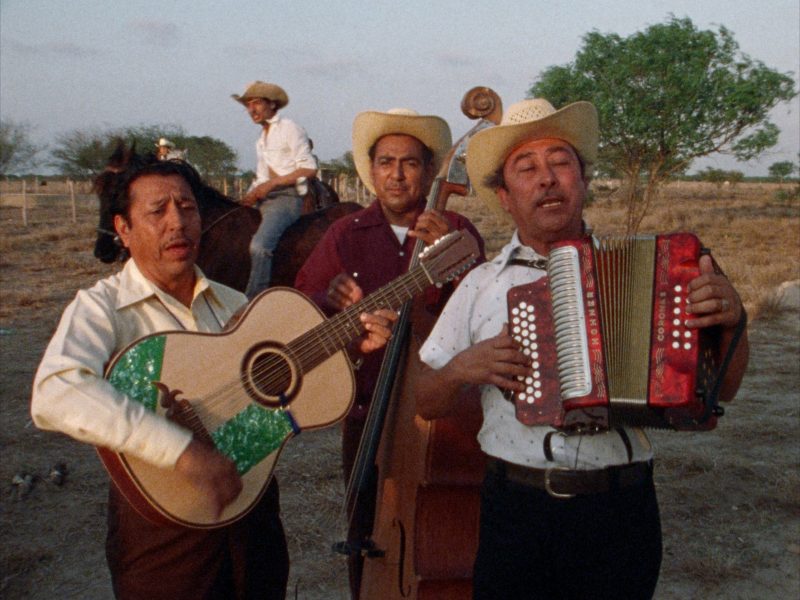
Chulas Fronteras, director Les Blank’s affectionate 1976 documentary about Mexican American music and culture in Texas, was screened at the Lightbox Film Center on Friday, August 9.
Blank’s focus in Chulas Fronteras, which translates as “beautiful borders,” is norteño, also known as conjunto, a rollicking, fast-paced music that took German polkas and added Mexican elements. The music is played by small groups, often trios featuring accordion, standup bass, and a 12-string guitar called a bajo sexto.
Norteño originated among working-class people and is meant for dancing. Consequently, Blank takes his camera to the places like birthday parties, tiny cantinas, and modest church halls, where musicians like Narciso Martínez and the duo Los Alegres de Terán regularly perform.
Chulas Fronteras is one of more than 40 movies Blank made between 1960 and 2007. The director, who died in 2013, is probably best known for Burden of Dreams, a feature-length documentary about Werner Herzog’s struggle to make the movie Fitzcarraldo, but music, food, and festivity are Blank’s primary interest. His movies include The Blues Accordin’ to Lightnin’ Hopkins and Garlic Is as Good as Ten Mothers.
Those concerns are evident in Chulas Fronteras. Early in the film, Blank visits a backyard barbecue. While a song of deep romantic longing plays, the camera follows men as they shovel burning embers into the grill, slice avocados, and mash tomatoes for the salsa. At one point, the camera pans across the attendees and viewers get a momentary glimpse of Blank, who is sipping from a bottle of beer.
Blank also uses the imagery of a shared meal to introduce Lydia Mendoza, an acclaimed Tejano singer and musician, who’d been making music since the 1930s. Mendoza is shown at home preparing her Christmas Eve meal. As “Mal Hombre,” her most famous song, plays in the background, viewers watch her making tamales. Mendoza makes the stuffing while another woman strips flesh from a pig’s head. Relatives and friends are greeted with hugs—and a hot tamale. Blank cuts from this domestic scene to a performance by Mendoza. The audience knows her and her songs so well, it’s as if they’re family, too.
Blank is a hedonist of sorts, albeit a cheerful, undogmatic one, but he’s not oblivious to reality. The Mexican Americans who welcomed him into their homes are primarily employed in agriculture, where they do back-breaking work for meager wages. Moreover, they are discriminated against because of their skin color and the fact that they speak Spanish. Rather than have so-called experts explain this, Blank lets the people he films have their say.
Roughly a third of the way through the movie, Blank shows a local DJ named Willie Lopéz broadcasting from a radio station in Reynosa, just across the Rio Grande from McAllen, Texas. After some patter, Lopéz asks, “Do you remember this corrido about the melon strike?” before playing a song he wrote called “Rinches de Texas” (“The Texas Rangers”). The song is about a strike by farm laborers that was brutally put down in June of 1967. Blank cuts to an onion field, where laborers harvest the crop; then cuts again to a packing plant, where women sort the onions; and cuts yet again to a warehouse where men load heavy bags of onions onto trucks. In the background, Lopéz’s ballad continues: “The governor sent in those hated Rangers / To protect the melons of a rich conservative.”
Elsewhere, Blank is a bit more sly and oblique regarding politics. Panning his camera across a farm building, viewers might see the Aztec Eagle, a symbol of Cesar Chavez’s United Farm Workers, or notice a clenched fist spray-painted on a brick wall. But Blank’s camera doesn’t linger on these images. Throughout the film, class, identity, and race are treated similarly: They are neither belittled, denied, nor ignored. But they are also not viewed as topics Chicanos must explain to outsiders, including viewers like us.
A highlight of Chulas Fronteras is the scene where Rumel Fuentes and Los Pingüinos del Norte play the song “Chicano.” The musicians are obviously enjoying themselves, and they’re playing to an appreciative audience. “Chicano, soy Chicano. / Cause I’m brown and I’m proud / And I’ll make it in my own way,” sings Fuentes. As the music continues, Blank intercuts brief images from a cockfight before returning to the band, who end the song to hearty applause. That “Chicano” was written by Doug Sahm, a white musician associated with Austin’s “cosmic cowboy” scene, makes no difference. Fuentes and the band put their own stamp on it.
Chulas Fronteras doesn’t only show good times; it also documents a culture at a specific time and place, in a sense preserving it. That’s partly why the Library of Congress added it to the National Film Registry in 1993, making it one of two films by Blank awarded that recognition. Undoubtedly, the lives of these working-class Mexican Americans living in Texas in the mid-1970s were about to be transformed by changes that would affect all Americans, including the conservatism that Reagan ushered in, the corporatization of work, and the digital revolution.
As wonderful as the newly remastered Chulas Fronteras is, it comes at a particularly grievous time. When Blank originally released the movie, it was a cheeky rejoinder to the Bicentennial’s odd mix of hucksterism, nostalgia, and patriotism. Today, the national mood is ominous. The screening at the Lightbox Film Center was preceded by mass shootings at the Gilroy Garlic Festival and a Walmart in El Paso, as well as a mass roundup of so-called “undocumented workers” by Immigration and Customs Enforcement agents at food processing plants in Mississippi. In each instance, Latinos were targeted.
Blank’s quirky sense of humor and poetic style of documentary filmmaking would seem to offer little help in mitigating such bigotry and violence. The sheer charisma of Flaco Jiménez, who brings the house down with a rocking version “Un Mojado Sin Licencia,” is unlikely to change the hearts of those convinced that America is being “invaded” by “illegal immigrants.” And that’s a damn shame.
“Chulas Fronteras” is free to stream on Kanopy if you have a public library card and if your library participates (Philadelphia Free Library does!).









